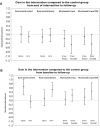Musculoskeletal Benefits from a Physical Activity Program in Primary School are Retained 4 Years after the Program is Terminated
- PMID: 33914096
- PMCID: PMC8429376
- DOI: 10.1007/s00223-021-00853-0
Musculoskeletal Benefits from a Physical Activity Program in Primary School are Retained 4 Years after the Program is Terminated
Abstract
Daily school physical activity (PA) improves musculoskeletal traits. This study evaluates whether the benefits remain 4 years after the intervention. We followed 45 boys and 36 girls who had had 40 min PA/school day during the nine compulsory school years and 21 boys and 22 girls who had had 60 min PA/school week (reference), with measurements at baseline and 4 years after the program terminated. Bone mineral content (BMC; g) and bone mineral density (BMD; g/cm2) were measured by dual-energy X-ray absorptiometry and knee flexion peak torque relative to total body weight (PTflexTBW) at a speed of 180 degrees/second with a computerized dynamometer. Group differences are presented as mean differences (adjusted for sex and duration of follow-up period) with 95% confidence intervals. The total gain bone mass [mean difference in spine BMC +32.0 g (14.6, 49.4) and in arms BMD of +0.06 g/cm2 (0.02, 0.09)] and gain in muscle strength [mean difference in PTflex180TBW +12.1 (2.0, 22.2)] were greater in the intervention than in the control group. There are still 4 years after the intervention indications of benefits in both bone mass and muscle strength gain. Daily school PA may counteract low bone mass and inferior muscle strength in adult life. ClinicalTrials.gov.NCT000633828 retrospectively registered 2008-11-03.
Trial registration: ClinicalTrials.gov NCT00633828.
Keywords: Bone mineral content; Bone mineral density; Children; Muscle strength; Physical activity.
© 2021. The Author(s).
Conflict of interest statement
There are no conflicts of interest or competing interests for any of the authors.
Figures


Similar articles
-
Physical Activity at Growth Induces Bone Mass Benefits Into Adulthood - A Fifteen-Year Prospective Controlled Study.JBMR Plus. 2021 Nov 26;6(1):e10566. doi: 10.1002/jbm4.10566. eCollection 2022 Jan. JBMR Plus. 2021. PMID: 35079677 Free PMC article.
-
Effects of an 8-year childhood physical activity intervention on musculoskeletal gains and fracture risk.Bone. 2016 Dec;93:139-145. doi: 10.1016/j.bone.2016.09.021. Epub 2016 Sep 24. Bone. 2016. PMID: 27678059
-
A 6-year exercise program improves skeletal traits without affecting fracture risk: a prospective controlled study in 2621 children.J Bone Miner Res. 2014 Jun;29(6):1325-36. doi: 10.1002/jbmr.2168. J Bone Miner Res. 2014. PMID: 24390777 Clinical Trial.
-
Exercise and Peak Bone Mass.Curr Osteoporos Rep. 2020 Jun;18(3):285-290. doi: 10.1007/s11914-020-00588-1. Curr Osteoporos Rep. 2020. PMID: 32249382 Free PMC article. Review.
-
[Daily school physical activity increases bone mass and gradually reduce the fracture risk].Lakartidningen. 2019 Mar 19;116:FHP7. Lakartidningen. 2019. PMID: 31192412 Review. Swedish.
Cited by
-
Utilizing physical educators to monitor muscular strength and neuromuscular control among children with varied recess time.Front Sports Act Living. 2025 Feb 6;7:1527810. doi: 10.3389/fspor.2025.1527810. eCollection 2025. Front Sports Act Living. 2025. PMID: 39981509 Free PMC article.
-
Physical Activity at Growth Induces Bone Mass Benefits Into Adulthood - A Fifteen-Year Prospective Controlled Study.JBMR Plus. 2021 Nov 26;6(1):e10566. doi: 10.1002/jbm4.10566. eCollection 2022 Jan. JBMR Plus. 2021. PMID: 35079677 Free PMC article.
-
Physical Activity in Late Prepuberty and Early Puberty Is Associated With High Bone Formation and Low Bone Resorption.Front Physiol. 2022 Apr 7;13:828508. doi: 10.3389/fphys.2022.828508. eCollection 2022. Front Physiol. 2022. PMID: 35464077 Free PMC article.
-
The long-term effects of primary school-based obesity prevention interventions in children: A systematic review and meta-analysis.Pediatr Obes. 2023 Mar;18(3):e12997. doi: 10.1111/ijpo.12997. Epub 2022 Dec 21. Pediatr Obes. 2023. PMID: 36545748 Free PMC article.
References
Publication types
MeSH terms
Associated data
Grants and funding
LinkOut - more resources
Full Text Sources
Other Literature Sources
Medical

